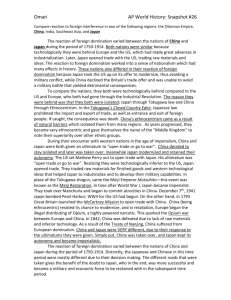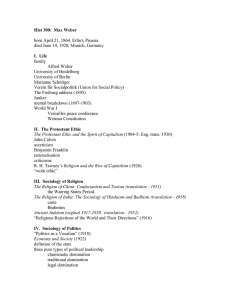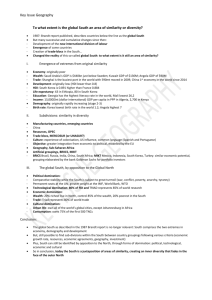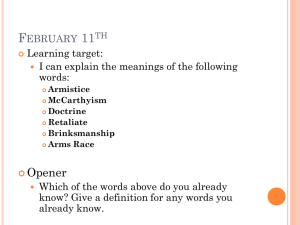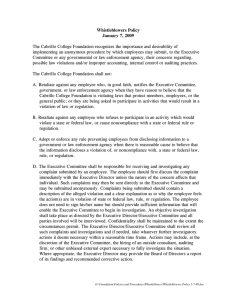RETALIATE: Learning Winning Policies in First-Person Shooter Games Abstract
advertisement
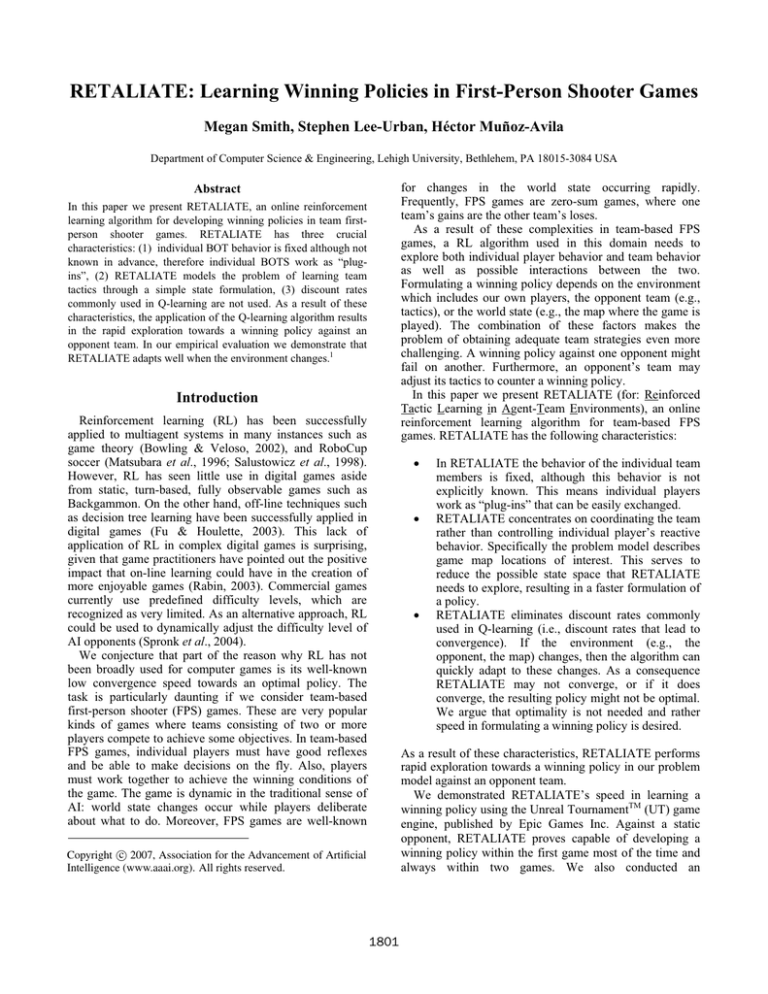
RETALIATE: Learning Winning Policies in First-Person Shooter Games
Megan Smith, Stephen Lee-Urban, Héctor Muñoz-Avila
Department of Computer Science & Engineering, Lehigh University, Bethlehem, PA 18015-3084 USA
for changes in the world state occurring rapidly.
Frequently, FPS games are zero-sum games, where one
team’s gains are the other team’s loses.
As a result of these complexities in team-based FPS
games, a RL algorithm used in this domain needs to
explore both individual player behavior and team behavior
as well as possible interactions between the two.
Formulating a winning policy depends on the environment
which includes our own players, the opponent team (e.g.,
tactics), or the world state (e.g., the map where the game is
played). The combination of these factors makes the
problem of obtaining adequate team strategies even more
challenging. A winning policy against one opponent might
fail on another. Furthermore, an opponent’s team may
adjust its tactics to counter a winning policy.
In this paper we present RETALIATE (for: Reinforced
Tactic Learning in Agent-Team Environments), an online
reinforcement learning algorithm for team-based FPS
games. RETALIATE has the following characteristics:
Abstract
In this paper we present RETALIATE, an online reinforcement
learning algorithm for developing winning policies in team firstperson shooter games. RETALIATE has three crucial
characteristics: (1) individual BOT behavior is fixed although not
known in advance, therefore individual BOTS work as “plugins”, (2) RETALIATE models the problem of learning team
tactics through a simple state formulation, (3) discount rates
commonly used in Q-learning are not used. As a result of these
characteristics, the application of the Q-learning algorithm results
in the rapid exploration towards a winning policy against an
opponent team. In our empirical evaluation we demonstrate that
RETALIATE adapts well when the environment changes.1
Introduction
Reinforcement learning (RL) has been successfully
applied to multiagent systems in many instances such as
game theory (Bowling & Veloso, 2002), and RoboCup
soccer (Matsubara et al., 1996; Salustowicz et al., 1998).
However, RL has seen little use in digital games aside
from static, turn-based, fully observable games such as
Backgammon. On the other hand, off-line techniques such
as decision tree learning have been successfully applied in
digital games (Fu & Houlette, 2003). This lack of
application of RL in complex digital games is surprising,
given that game practitioners have pointed out the positive
impact that on-line learning could have in the creation of
more enjoyable games (Rabin, 2003). Commercial games
currently use predefined difficulty levels, which are
recognized as very limited. As an alternative approach, RL
could be used to dynamically adjust the difficulty level of
AI opponents (Spronk et al., 2004).
We conjecture that part of the reason why RL has not
been broadly used for computer games is its well-known
low convergence speed towards an optimal policy. The
task is particularly daunting if we consider team-based
first-person shooter (FPS) games. These are very popular
kinds of games where teams consisting of two or more
players compete to achieve some objectives. In team-based
FPS games, individual players must have good reflexes
and be able to make decisions on the fly. Also, players
must work together to achieve the winning conditions of
the game. The game is dynamic in the traditional sense of
AI: world state changes occur while players deliberate
about what to do. Moreover, FPS games are well-known
x
x
x
In RETALIATE the behavior of the individual team
members is fixed, although this behavior is not
explicitly known. This means individual players
work as “plug-ins” that can be easily exchanged.
RETALIATE concentrates on coordinating the team
rather than controlling individual player’s reactive
behavior. Specifically the problem model describes
game map locations of interest. This serves to
reduce the possible state space that RETALIATE
needs to explore, resulting in a faster formulation of
a policy.
RETALIATE eliminates discount rates commonly
used in Q-learning (i.e., discount rates that lead to
convergence). If the environment (e.g., the
opponent, the map) changes, then the algorithm can
quickly adapt to these changes. As a consequence
RETALIATE may not converge, or if it does
converge, the resulting policy might not be optimal.
We argue that optimality is not needed and rather
speed in formulating a winning policy is desired.
As a result of these characteristics, RETALIATE performs
rapid exploration towards a winning policy in our problem
model against an opponent team.
We demonstrated RETALIATE’s speed in learning a
winning policy using the Unreal TournamentTM (UT) game
engine, published by Epic Games Inc. Against a static
opponent, RETALIATE proves capable of developing a
winning policy within the first game most of the time and
always within two games. We also conducted an
c 2007, Association for the Advancement of Artificial
Copyright Intelligence (www.aaai.org). All rights reserved.
1801
experiment showing that RETALIATE can adapt to a
changing environment.
The paper continues as follows. We discuss related work
in the next section, including a brief overview of
reinforcement learning. Next, we discuss domination
games in Unreal TournamentTM (UT), which is the kind of
team-based FPS game we used in our experiments.
Following that comes the main section of this paper, which
explains our model of the learning problem. Then we
discuss our empirical evaluation. We conclude this paper
with final remarks.
backgammon is turn-based and the world is static and fully
observable. In contrast, FPS games are real-time and the
world is dynamic and only partially observable. Both
backgammon and FPS games are nondeterministic.
Spronck & Ponsen (2004) use reinforcement learning to
generate AI opponent scripts which can adapt to a player’s
behavior in a real-time strategy game. A similar technique
is used in a role-playing game (Ponsen et al, 2004). This
work differs with ours in the granularity of the learning
problem. In Spronck’s work the units are learning
individual policies; for example, which opponent to attack
and which weapon or spell to use based upon the
individual unit’s capabilities. In our work, RETALIATE is
learning a team policy. Another major difference is the
pace of the game. FPS games are well-known for having a
faster pace than role-playing and real-time strategy games.
Related Work
Computer games are considered by some to be the
“killer app” for human-level AI, and coordinating behavior
is one of many research problems they present (Laird et al.,
2001). FPS games are particularly interesting because they
present real-time requirements and provide a rich, complex
environment. Another advantage is that, unlike the
RoboCup domain where an agent’s sensors can fail or
provide inaccurate information, FPS games have perfect
sensors that never fail. Also FPS games can avoid the need
to consider team member communication, as is necessary
in work described by Sen et al. (1994) and Lauer &
Riedmiller (2000). This reduced complexity allows
experiments to focus on coordination issues in a way not
complicated by noise or communication protocols. Outside
of game environments, controlling team agents is an
important research topic (e.g., (Nair & Tambe, 2005)).
One example of coordinating bots was by Hoang et al.
(2005). In that study, hierarchical task networks (HTNs)
were used to encode strategic behavior that created
cohesive behavior in a team of bots. The results
demonstrated a clear dominance by the HTN team. In spite
of the success, the strategy was encoded a priori
specifically for the scenarios. No machine learning was
involved.
Agents in RL operate under uncertainty. How can the
agent, solely by trial-and-error interaction with the
environment, determine the best action for a given state?
One of the key aspects in RL is balancing between trying
new actions that have unknown rewards – exploring – and
those actions already tried with predictable rewards –
exploiting. The agent’s goal in a RL problem is to
maximize its total reward. (Sutton & Barto, 1998).
RL has been used with success in certain classes of
computer games. One of the most well-known examples is
Gerry Tesauro’s implementation of a RL agent, called TDGammon, that plays backgammon at a skill-level equal to
the world’s best human players. In addition to proving the
power of the RL approach, TD-Gammon revolutionized
backgammon when it arrived at game strategies previously
unexplored by grandmasters, yet found to be equally
effective (Tesauro, 1995). However, the backgammon
domain is starkly different from the FPS domain in that
Domination Games in UT
UT is a FPS game in which the usual objective is to
shoot and kill an opponent. Players track their health and
their weapon’s ammunition, as well as attempt to pick up
various items strewn about the map. Opponents may be
other human players via online multiplayer action or
computer-controlled bots. An interesting feature of UT is
the ability to play several different game variants. One of
these variants is a domination game, a feature offered by
almost every team-based multiplayer game.
A domination game map has two or more domination
locations, each of which can be owned by any team. A
team scores points by controlling one or more domination
locations. The last team that touches a domination location
owns that domination location. For example, in a
domination game with two teams and three domination
locations, the team that owns two domination locations
scores points twice as fast as the team that only owns one
domination location. However, if the second team captures
one of the first team’s domination locations, the scoring
reverses and the second team scores points twice as fast as
the first team. A domination game ends when one team
scores a predetermined number of points, in which case
that team is declared the winner. In the experiments, games
were played to 50 points.
RL for Coordinating Teams of Bots
We used reinforcement learning techniques to learn a
winning policy to play a domination game in UT. A policy
indicates for every possible state which action to take. A
winning policy is one where the action taken at every state
will lead to a victorious outcome.
Problem Model
A set of states and associated actions model the
reinforcement learning problem domain, that we call
1802
henceforth the problem model. For an UT domination
game, the states consist of the Cartesian product ioi of the
owner oi of the domination location i. For instance, if there
are 3 domination locations, the state (E,F,F) notates the
state where the first domination location is owned by the
enemy and the other two domination locations are owned
by our friendly team. Other parameters were considered to
increase the information contained in each state, however,
through experiments, we found not only did this simpler
definition greatly reduce the state space, but contained
sufficient information to develop a winning policy. For
three domination locations and two teams, there are
twenty-seven unique states of the game, taking into
account that domination locations are initially not owned
by either team. The initial state is denoted by (N,N,N);
indicating that the locations are not owned by any team.
States have an associated set of team actions. A team
action is defined as the Cartesian product iai of the
individual action ai that bot i takes. For example, for a
team consisting of three bots, a team action would consist
of the Cartesian product of three individual actions. An
individual action specifies to which domination location
the bot should move. For example, in one team action, the
three individual actions could send bot1 to domination
location 1, bot2 to domination location 2, and bot3 to
domination location 3. A second team action might have
individual actions sending all three bots to domination
location 1. For a state with three domination locations there
are twenty-seven unique team actions because each bot can
be sent to three different locations. If the bot is already in
that location, the action is interpreted as to stay in its
current location. Individual actions by different bots are
executed in parallel.
Despite the simplicity in the representation of our
problem model, it not only proves effective but it actually
mimics how human teams play domination games. The
most common error of novice players in this kind of game
is to fight opponents in locations other than the domination
ones. This typically leads to a severe warning by more
experienced players as these fights generally do not
contribute to win these kinds of games. Part of the reason
is if a player is killed, it simply reappears in a random
location and has no effect in the score. Also players
communicate to which domination points other player
should go. This is precisely the kind of behavior that our
problem model represents.
Before continuing, we refer to game instance as one
episode where both teams start with 0 points and the initial
state is (N,N,N) and ends with one of the teams reaching
the predefined number of points.
1
2
3
4
5
RETALIATE(numGameInstances, H, D)
input: H: rate of random exploration,
D: step-size parameter
output: none
For every state S {EEE, …, FFF}
For every action A {<Go(x), Go(y), Go(z)>… }
Q[S, A] Å 100
For i Å 1 to numGameInstances
Q-table[] Å runRETALIATE(H, D, Q-table[])
changes in our own players, changes in the opponent team
(e.g., change of tactics), or changes in the world state (e.g.,
game instance is played in a new map). RETALIATE
receives as parameters the number of games
numGameInstances that the algorithm will be run (used in
the experiments), H: rate of random exploration, D, the
step-size parameter, which influences the rate of learning.
RETALIATE starts by initializing the Q-values with a
default value (lines 1-3). Then runRETALIATE is called
subsequently for each new game instance, passing as
parameter the Q-values from the previous run (lines 4-5).
1
2
3
4
5
runRETALIATE(H, D, Q-table[1..#states,1..#actions])
input: H: rate of random exploration, D: step-size
parameter
output: updated Q-table[1..#states,1..#actions]
BeginGame()
k Å 0; Initialize state s
While not( EndGame() )
Ak Å actionsInState(s)
Choose
i) with probability 1- H:
a Å action A satisfying max Q[s, A]
AAk
ii) OR with probability H:
a Å random action A in Ak
6
executeAction(a)
//blocking call
7
s' Å currentState()
8
R = U(s’) – U(s)
Q(s, a) ĸ
9
Q(s, a) + D ( R + Ȗ maxa’ Q(s’, a’) – Q(s, a))
10
s Å s’
11
kÅk+1
12 Return Q[]
Above we show the runRETALIATE algorithm, which
runs during one game instance. First the game is started
(line 1), the iterator k is initialized (line 2). The following
loop (lines 3-11) continues iterating while the game
instance is not finished. The set of possible actions Ak for
the state s is assigned (line 4). Line 5 picks the team action
a to be executed; the team action with the highest Q-value
for the given state is chosen with a probability 1- H, or a
random team action from all those available is chosen with
a probability H. RETALIATE executes the selected team
action a (Line 6) and observes the resulting state, s’ (Line
7). Each bot can either succeed in accomplishing its
The RETALIATE Algorithm
Below we show the top level of the RETALIATE
online learning algorithm. RETALIATE is designed to run
continuously for multiple game instances. This is needed
as there is never a final winning policy. Rather, the
RETALIATE-controlled team adapts continuously to
changes in the environment. These changes include:
1803
individual action or fail in doing so (e.g., the bot is killed
before it could accomplish its action). Either way,
executing a team action takes only a few seconds because
the individual actions are executed in parallel. Line 8
computes the reward as the difference between the utilities
in states s and s’. Line 9 performs an update on the Qvalue. The Q-value for the pair (state,action) from the
previous iteration (k-1) is updated (we discuss this formula
in detail later on). In the last instructions of the loop, the
state s is updated and the iterator k is incremented (Lines
10-11).
There are three aspects of the algorithm that we want to
discuss in some detail:
x
x
x
Team Name
HTNBot
OpportunisticBot
PossesiveBot
Utility. The utility u of state s is defined by the
function U(s) = F(s) – E(s), where F(s) is the
number of friendly domination locations and
E(s) is the number of enemy-controlled
domination locations. For example, relative to
team A, a state in which team A owns two
domination locations and team B owns one
domination location has a higher utility than a
state in which team A owns only one
domination location and team B owns two.
Action
Selection.
Step
5
of
the
runRETALIATE algorithm shows the H-greedy
policy used by RETALIATE. Most of the time
(with probability 1- H) RETALIATE chooses
the action for the current state s that has the
maximum Q-value. But with probability H
RETALIATE chooses a random action.
Policy update. In Step 9 of the
runRETALIATE algorithm, the Q-value for the
pair (state,action) from the previous iteration
(k-1) is updated with the step-size parameter D
multiplied by the difference in utility between
the current state and the previous state. If the
utility increases, the Q-value is increased,
otherwise it is decreased. This is the standard
formula for computing Q-values (Sutton &
Barto, 1998).
GreedyBot
Description
The HTNbot is described in (Hoang
et al., 2005); it uses HTN planning
techniques trying to maintain
control of half plus one of the
locations.
Does not coordinate among
members whatsoever but each bot
actively looks for a domination
location to capture it.
Each bot is assigned a single
domination location that it attempts
to capture and hold during the
whole game
Attempts to recapture any location
that is taken by the opponent
Table 1: Description of the 4 teams used in testing and
training of RETALIATE.
Empirical Evaluation
We ran two experiments. For these experiments we used
the Gamebots distribution (Gamebot, 2005) and the UT
game. All bots use the same state machine to control their
reactive behavior. For example, they fire at an enemy on
sight, or pick up an inventory item if near one. This
ensures a fair comparison of team strategies as no
individual bot is better than the others. Pathfinding is
determined by the UT game. While moving, the bots
continue to react to game events as determined by their
reactive state machine. Initially the bots do not know the
location of the domination location. Therefore they are
programmed to find those locations first. The information
about locations found is shared among teammates.
We used the DOM-Stalwart map that comes with the
Gamebots distribution. This map contains three domination
locations. For every game instance of each experiment, we
recorded the map used, the time taken, the score history,
and the number of iterations of runRETALIATE.
Because of the nature of the game and the real-time
updates and actions of the bots, an average of 150 actions
are taken during the course of a single game. This allows
RETALIATE to develop a strategy during the course of
single game as opposed to many games.
RETALIATE was called with the following values for
the parameters. H: 0.1, D: 0.2, and numGameInstances : 10.
These parameters were established by doing statistical
sampling based on some trial runs.
One point to note is the diversion from the traditional
discounting of rewards by setting Ȗ = 1 instead of a value
less than 1. Non-discounted rewards normally means that
there would be no convergence of the algorithm to an
optimal policy. This means that while the Q-function may
be effective for a given opponent on a given map, a change
in opponent strategy or the map will result in an again
unstable Q-function and the exploration for a better
strategy begins again. The common practice in Q-learning
of setting Ȗ to something less than one was not effective in
this highly dynamic domain because a stable convergence
was undesirable. The strategy needs the ability to adjust to
changing opponents and environments quickly enough to
be effective.
Changing Environments
In the first experiment, we ran 5 trials of 10 game
instances each. A trial was a single run of RETAILIATE
with numGameInstances set to 10 (i.e. the q-table was
retained across the 10 games). Within each trial, we ran
RETALIATE against 3 opponent teams: opportunistic,
possessive, and greedy as described in Table 1. In order to
1804
state was not effective against that opponent (and
consequently a new policy was explored). In the final
game, there are fewer periods of exploration by
RETALIATE due to already having obtained an effective
strategy against their opponent.
Figure 3 shows the average score over time of the second
game across the 5 trials. We observe that early within the
second game, RETALIATE begins to develop a winning
strategy.
observe how RETALIATE adapts to a changing
environment, we iterated through the three opponents. On
the first game of each trial, the opponent was opportunistic.
On the second game of each trial, the opponent was
possessive (and the third greedy). This pattern was
continued thereafter.
The results of this experiment are shown in Figure 1.
The x-axis indicate the game instances and the y-axis
indicate the final score. The score indicates the average of
5 runs of 10 game instances each. So for example, in game
instance number 5 RETALIATE lost some games and as a
result the average is less than 50. In total, RETALIATE
won 47 out of the 50 game instances. The results clearly
show that within one game RETALIATE is able to obtain a
winning policy an overwhelming majority of the times.
60
50
score
40
30
Dynamic Opponent
20
In the second experiment, we ran 5 trials of 2 game
instances each (i.e. 5 trials of RETALIATE with
numGameInstances equal to 2). Within each trial, we ran
RETALIATE against HTNbots, a system that dynamically
changes its strategies. This opponent is considered to be
difficult. HTNbots (Muñoz-Avila & Hoang, 2006) uses
Hierarchical Task Network (HTN) planning techniques to
encode strategies that coordinate teams of bots. The HTN
planner SHOP (Nau et al., 1999) was used to generate the
strategy that is pursued by the bots. HTNbots keeps track
of the game and when the situation changes dramatically
SHOP is called to generate a new strategy “on the fly”.
HTNbots was able to beat all other opponents from Table 1
(Hoang et al., 2005). The interesting point of this
experiment is that we took a knowledge-intensive
opponent to compete against a learning opponent that
begins with no knowledge about winning strategies in the
game.
Figure 2 shows the average score over time of the first
game across the 5 trials (i.e. untrained RETALIATE). We
observe that the first game within each trial was very even.
This is noteworthy in that in the previous experiment,
RETALIATE was able to beat each of the opponents
within one game. At the beginning of the match bots
controlled by RETALIATE and HTNbots will explore the
map to find the domination locations. However, whereas
the HTNbots will only start executing the dynamic
strategies once all domination locations have been found,
RETALIATE will be punished/rewarded based on the state
and consequently immediately start developing a policy.
As a result the game is competitive from the outset.
The differences in score can be used to explain how
RETALIATE is working. A positive slope in this line
represents a point during which RETALIATE was
exploiting a previously learned effective strategy against
its opponent. The numerous dips in the slope of this line in
Figure 2 depict periods of exploration for RETALIATE.
Either a previously unvisited state in the game was
encountered, or the previously learned strategy for that
10
RETALIATE
Opponents
0
1
2
3
4
5
6
7
8
9
game instances
Figure 1: Results in a changing environment
60
RETALIATE
HTNbots
Difference
50
40
Score
30
20
10
0
-10
Time
Figure 2: Results versus HTNBots, first game.
60
50
40
Score
RETALIATE
HTNbots
Difference
30
20
10
0
-10
Time
Figure 3: Results versus HTNBots, second game.
1805
10
Lauer, M. & Riedmiller, M. An algorithm for distributed
reinforcement learning in cooperative multi-agent systems.
In Proceedings of the Seventeenth International
Conference on Machine Learning, pp 535-542, 2000.
Matsubara, H., Noda, I., & Hiraki, K. Learning of
cooperative actions in multiagent systems: a case study of
pass play in soccer. In Adaptation, Coevolution and
Learning in Multiagent Systems: AAAI Spring Symposium,
pgs. 63--67, 1996.
Muñoz-Avila, H. & Hoang, H. (2006) Coordinating
Teams of Bots with Hierarchical Task Network Planning.
In: AI Game Programing Wisdom 3. Charles River Media.
Nau, D., Cao, Y., Lotem, A., & Muñoz-Avila, H. SHOP:
Simple hierarchical ordered planner. Proceedings of the
Sixteenth International Joint Conference on Artificial
Intelligence (IJCAI-99). Stockholm: AAAI Press, 1999.
Ponsen, M. and Spronck, P. (2004). Improving Adaptive
Game AI with Evolutionary Learning. Computer Games:
Artificial Intelligence, Design and Education (CGAIDE
2004). pp. 389-396. University of Wolverhampton.
Rabin, S. Promising Game AI Techniques. In: AI Game
Programming Wisdom 2. Charles River Media, 2003.
Reynolds, J. Team Member AI in an FPS. In: AI Game
Programming Wisdom 2. Charles River Media, 2003.
Sen, S., Mahendra, S., Hale, J. Learning to Coordinate
Without Sharing Information. Proceedings of the Twelfth
National Conference on Artificial Intelligence, pp. 426431. 1994
Spronck, P., Sprinkhuizen-Kuyper, I. and Postma. E.
2004. Online Adaptation of Game Opponent AI with
Dynamic Scripting. International Journal of Intelligent
Games and Simulation, Vol. 3, No. 1, University of
Wolverhampton and EUROSIS, pp. 45–53.
Sutton, R. S. & Barto, A. G. Reinforcement Learning:
An Introduction, MIT Press, Cambridge, MA, 1998.
Nair, R. & Tambe, M. Journal of AI Research (JAIR),
23:367–420, 2005.
Tesauro, G. Temporal Difference Learning and TDGammon. In Communications of the ACM, March 1995 /
Vol. 38, No. 3, 1995.
van Lent, M., Laird, J. E., Buckman, J., Hartford, J.,
Houchard, S., Steinkraus, K. and Tedrake, R., Intelligent
Agents in Computer Games. Proceedings of the National
Conference on Artificial Intelligence, pp. 929-930, 1999.
Watkins, C. J. Models of Delayed Reinforcement
Learning. Ph.D. thesis, Psychology Department,
Cambridge University, Cambridge, UK, 1989.
Yiskis, E. A Subsumption Architecture for CharacterBased Games. In: AI Game Programming Wisdom 2.
Charles River Media, 2003.
Final Remarks
The potential commercial applicability of the capability to
generate adaptive team tactics is significant (van Lent et
al., 1999). FPS games typically provide a toolset allowing
players to design their own maps. Therefore the potential
number of different maps that can be generated can be
considered, from a practical perspective, unbounded. As
such, encoding adequate team tactics in advance and the
conditions under which they are applicable is an extremely
difficult problem. This problem is compounded by the fact
that in online games, teams are formed by combining
players of varying capabilities; as a consequence, making a
profile of team capabilities, which would allow the
selection of adequate tactics a priori, is almost impossible.
To overcome the difficulty posed to pre-encoded
strategies, we presented RETALIATE, an online
reinforcement learning algorithm for team FPS games.
RETALIATE voids discounted rewards in order to quickly
adapt to changes in the environment. This is particularly
crucial for FPS games where the world state can change
very rapidly. RETALIATE’s problem model is simple yet
effective. Our empirical evaluation confirms the
effectiveness of RETALIATE to find winning policies
given our problem model.
Acknowledgements
This research is funded in part by the Naval Research
Laboratory (subcontract to DARPA's Transfer Learning
program), and the National Science Foundation. The
opinions in this paper are those of the authors and do not
necessarily reflect the opinions of the funders.
References
Bowling, M. & Veloso, M. Multiagent learning using a
variable learning rate. Artificial Intelligence, vol. 136, no.
2, pp. 215--250, 2002.
Fu & Houlette. Constructing a Decision Tree Based on
Past Experience. AI Game Programming Wisdom 2.
Charles River Media, 2003.
Gamebot. http://www.planetunreal.com/gamebots/. Last
viewed: January 24, 2005.
Hoang, H., Lee-Urban, S., and Muñoz-Avila, H.
Hierarchical Plan Representations for Encoding Strategic
Game AI. Proceedings of Artificial Intelligence and
Interactive Digital Entertainment Conference (AIIDE-05).
AAAI Press. 2005
Kent, T. Multi-Tiered AI Layers and Terrain Analysis
for RTS Games. In: AI Game Programming Wisdom 2.
Charles River Media, 2003.
Laird, J.E., & van Lent, M. Interactive computer games:
Human-level AI’s killer application. AI Magazine, 22(2),
15-25. 2001
1806
